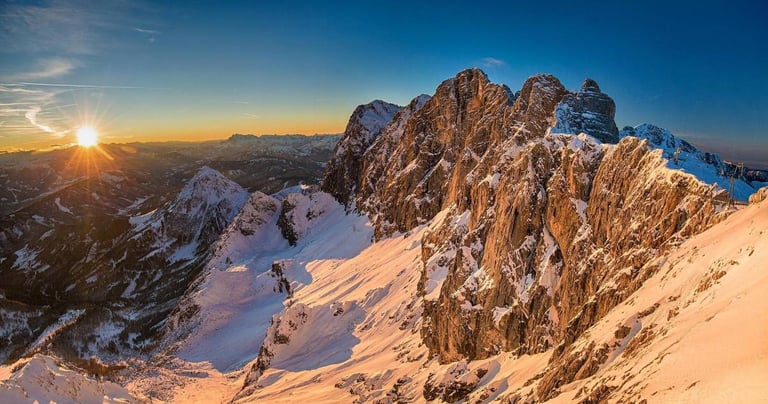11 Facts About Mountains
Explore the amazing world above the sky by learning 11 amazing facts about mountains, from majestic peaks to overlooked ecosystems.
FACTS ABOUT


Mountain (credit: pixabay)
Allow us to face it, when we see mountains, we usually have thoughts, "Gosh, that is massive," and then we go on. Beyond their striking height, however, there is much more to be discovered behind those peaks. I was mistaken to believe that mountains were merely beautiful backgrounds for postcards and hiking pictures. They are detailed, ever-evolving, packed with discoveries, unusual and lovely. These 11 facts can help you understand what is going on far above sea level, whether you are a geography lover, an outdoor fan, or simply inquisitive.
Mountains Cover One-Fifth of Earth's Surface: Yes, mountains make up around 20% of the planet's land area. That is a huge portion of our world that provides exclusive natural environments, shapes global weather trends, and sets up obstacles for both humans and wildlife. These massive landforms have a significant impact on how ecological systems work all throughout the world, rather than simply on local climates.
Mountains Are Still Growing or Shrinking: Although it appears like something from an imaginary book, it is true: Because of tectonic plate shifting, mountains like the Himalayas continue to rise. At the same time, erosion is gradually eroding old ranges like the Appalachians. Consider if Earth is continuously changing its terrain, a single shift at a moment.
Mountains Host Unique Ecosystems by Altitude: If you ascend a high mountain, you are going to discover something strange: you are moving through several temperature ranges as you get higher. It may feel similar to the Arctic tundra at the top, a temperate woodland in the center, and a rainforest at the bottom. It is similar to following the same route from the equator to the poles.
Mountains Are Home to Over 85% of the World's Amphibians: It would seem that amphibians would choose wetlands or swamps, however, mountains offer the ideal balance of moisture and cold temperatures. These areas provide an environment of peaceful sanctuary that amphibians seek out; secluded waterways, shady moss beds, and a smaller number of predators.
Mountains Can Create "Rain Shadows": Have you ever questioned why great mountain ranges are adjacent to deserts like the Atacama? The rain shadow effect is to blame. Rain falls on one side of a mountain after moist air strikes it, rises, and cools. It is dry by the moment that it reaches the opposite side. It resembles the one-sided sponge seen in Mother Nature.
Mountains Can Generate "Mountain Waves": Mountain waves are unnoticeable, chaotic air currents that can suddenly discomfort an airplane as wind rushes over mountain tops. Pilots must exercise extra caution whenever flying close to tall mountains. It is one of those hidden risks that most travellers are unaware of.
Mountains Can Cause Compass Errors: Iron-rich mountain landscapes can cause you to lose your direction if you have a strong preference for using a magnetic compass. The position of the needle may appear a little wrong because of magnetic interference, even if you are convinced that you are headed north. It is not the best option if you are attempting to navigate a distant route.
Mountains Can “Glow” at Night (Alpenglow): Have you ever observed how, shortly after sunset, the peaks of mountains appear to glow pink or orange? Alpenglow is more than simply a slogan. It occurs when high-altitude snow or rock mirrors the sun, which is slightly beyond the horizontal line, producing an enigmatic yet lovely brightness.
Mountains Influence Language Diversity: Mountain valleys frequently serve as linguistic time capsules because of their remote location. Communities of small populations preserve languages or entirety of languages that have vanished in other places due to limited accessibility and minimal external impact. These places resemble cultural havens that are kept hidden from view.
Mountains Are Crucial to Global Biodiversity Hotspots: Mountains are more than simply rock formations. Frequently having greater numbers of species per square kilometer than numerous lowland environments, they are filled with life. These high-altitude ecosystems are essential to the survival of numerous endangered vegetation and living things, ranging from orchids to snow leopards.
Mountains Can Hold Permafrost at Lower Latitudes: Permafrost, or permanently frozen ground, should remain in the Arctic, right? Not at all. High-altitude locations in East Africa or the Andes experience year-round freezing temperatures, even close to the equator. The regulations are actually changed by altitude.
Summary: Peaks of Discovery
Therefore, challenge yourself to recognize a mountain as a vibrant, living structure the following time you encounter one. It is more than simply a landscape; it is a slow-motion geological amazement, a language conservancy, a climate determiner, and a home to unexpected wildlife. Mountains formerly seemed like giant rocks to me. These days, they remind me more of Earth's archives, which are filled with natural events, old history, and strange knowledge that you would not know from afar. These peaks are worth more than a quick look, whether you are hiking them, flying over them, or simply taking in the views from a distance.
Additional Information: Learn something about the geology, climate, and animals of the area if you are thinking about going on an adventure or mountain expedition soon. The significance of the viewpoint is greatly increased when one is aware of what is truly happening up there.
